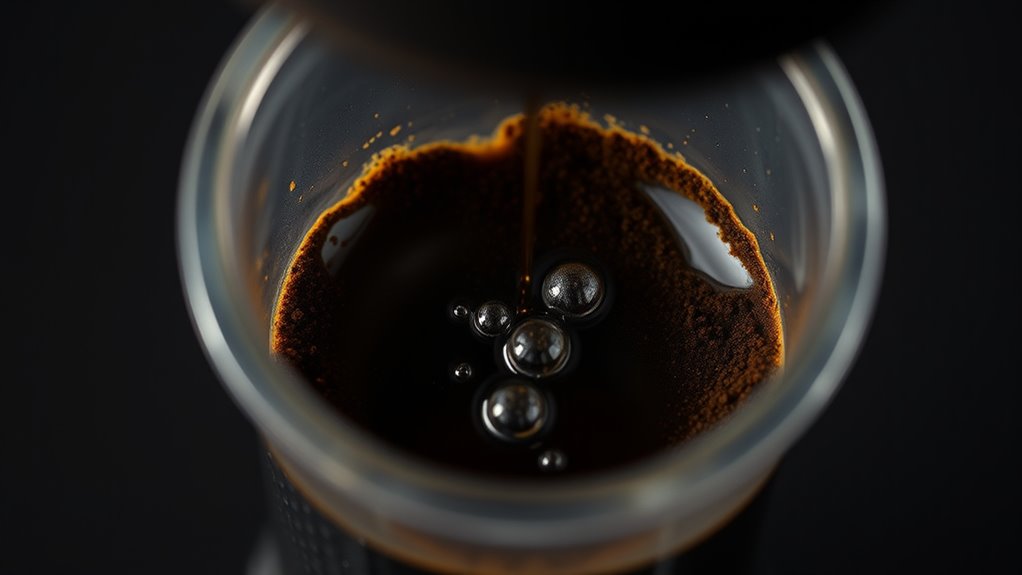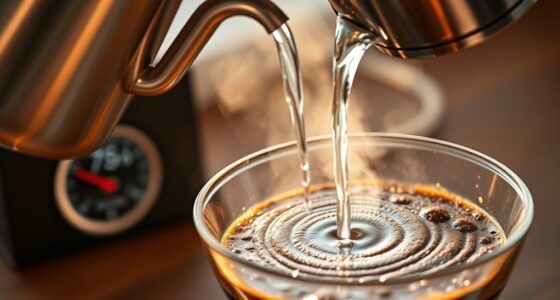To enhance AeroPress clarity with the delayed plunger technique, you should allow your coffee grounds to steep for about 30 seconds after pouring hot water—and then press slowly after a brief pause. This extended contact improves extraction, resulting in a cleaner, brighter cup with nuanced flavors. Adjusting your timing and pressure can fine-tune your brew to perfection. Keep exploring these steps, and you’ll discover even greater clarity and flavor in your AeroPress experience.
Key Takeaways
- Delaying the plunger increases contact time, allowing more flavor extraction and enhancing clarity.
- Steep for about 30 seconds before pressing to improve brightness and reduce sediment.
- Use a steady, gentle pressure to ensure even extraction and prevent channeling.
- Stir gently after pouring to promote uniform flavor development before delayed plunging.
- Adjust timing and grind size based on taste preferences for optimal clarity and flavor balance.
Understanding the Science Behind the Delayed Plunge

To understand the science behind the delayed plunger technique, it’s important to recognize how extraction works in an AeroPress. Coffee extraction involves dissolving flavors from coffee grounds into water, and pressure dynamics play a key role. When you press down, you create pressure that pushes water through the coffee bed, extracting solubles efficiently. By delaying the plunger, you allow more time for the water to interact with the grounds, resulting in better extraction. This extended contact enhances flavor development and clarity. The delayed plunger modifies pressure buildup, giving the coffee more opportunity to release desirable compounds. Understanding these pressure dynamics helps you control extraction, leading to a cleaner, more nuanced cup. Additionally, the technique leverages the timing and pressure to optimize flavor extraction in your AeroPress brew.
Benefits of the Delayed Plunger Method

The delayed plunger method offers several notable benefits that can elevate your AeroPress brewing experience. By adjusting brew timing, you gain more control over how flavors develop, leading to a richer and more balanced cup. This technique allows for better flavor extraction because the coffee grounds stay immersed longer, maximizing solubles without over-extraction. As a result, you’ll notice cleaner, brighter flavors and reduced bitterness. The delayed plunge also helps prevent channeling, ensuring even extraction throughout the brew. Plus, it offers flexibility—you can customize brew time based on your preferred strength and flavor profile. Additionally, understanding the importance of consistency in your brewing process can help achieve optimal results each time. Overall, this method enhances clarity and complexity in your coffee, making each cup a more satisfying and refined experience.
Step-by-Step Guide to Implementing the Technique

Getting started with the delayed plunger technique is straightforward. Begin by setting your brew temperature according to your preferred coffee profile, ensuring it’s ideal for extraction. Next, grind your coffee to a medium-fine consistency, similar to table salt, to promote clarity. Pour the hot water into your AeroPress, ensuring even saturation. Stir gently and let the coffee steep for about 30 seconds. After the steeping, wait a few seconds before pressing the plunger down slowly and steadily. The delay allows the coffee grounds to settle, reducing sediment and enhancing clarity. Maintaining consistent pressure as you press, avoiding rushing, is essential. Additionally, incorporating sound healing science principles by paying attention to your environment can help create a calm and focused brewing experience. With practice, you’ll find this method yields a cleaner, brighter cup, highlighting the delicate flavors and sharpness the delayed plunger technique offers.
Tips for Perfecting Your Clarity and Flavor

Refining your technique can make a noticeable difference in achieving the crisp clarity and vibrant flavors that the delayed plunger method promises. To guarantee brewing consistency, measure your coffee and water precisely each time. Use a consistent grind size and water temperature to avoid variations that can muddy clarity. Timing is key; gradually adjust your steep and plunge times to find the perfect balance that enhances flavor without over-extraction. Stir gently before plunging to evenly distribute coffee grounds, boosting clarity. Also, pay attention to your filter choice—using a high-quality paper filter can substantially improve clarity and reduce sediment. Additionally, selecting the proper filter type can further enhance the clarity of your brew. With practice, these small adjustments will elevate your AeroPress brew, delivering a cleaner, more flavorful cup each time.
Troubleshooting Common Challenges

Even with careful technique, you might encounter common challenges that affect your AeroPress clarity and flavor. One issue is muddled extraction, which results from uneven contact between coffee and water, leading to inconsistent taste. Another challenge is inconsistent pressure during pressing, causing uneven flow and potentially muddy espresso. To troubleshoot, review your grind size—finer grounds can improve extraction, while too fine may clog. Monitor your pressure to ensure steady, even force. Use this table to identify issues:
| Issue | Solution |
|---|---|
| Muddled extraction | Adjust grind size and tamp evenly |
| Inconsistent pressure | Practice steady, controlled pressing |
| Poor clarity | Use filtered water and proper brewing time |
| Weak flavor | Increase coffee dose or brew time |
| Over-extraction | Shorten brew or coarsen grind |
Ensuring your grind size is appropriate for your brewing method can greatly improve clarity. Applying these tips helps optimize clarity and flavor.
Frequently Asked Questions
Can the Delayed Plunger Technique Be Used With Other Coffee Brewing Methods?
You wonder if the delayed plunger technique can be used with other brewing methods. While it’s primarily an AeroPress-specific technique to improve clarity, you can explore alternative brewing methods like pour-over or French press for similar effects. Technique adaptation might involve adjusting steeping times or agitation to achieve clarity. However, the unique pressure-based process of the AeroPress makes this technique less applicable elsewhere, so experiment for the best results.
How Does Water Temperature Affect the Clarity Achieved With This Method?
You wonder how water temperature impacts brew clarity, especially with the delayed plunger technique. Higher water temperatures help extract more dissolved solids quickly, which can sometimes muddy the clarity. Cooler water produces a cleaner, brighter cup by limiting extraction. To optimize clarity, aim for a balanced temperature—around 175-185°F (80-85°C)—to control extraction and achieve a crisp, clear brew with the AeroPress.
Is There an Ideal Coffee Grind Size for Optimal Results?
You should aim for a medium-fine grind size for ideal results, as it balances extraction and flow. Ensuring consistent particle size is key, since uneven grind consistency can lead to cloudy or over-extracted coffee. When you match your grind size to the Delayed Plunger Technique, you get clearer, cleaner brews. Experiment with slight adjustments to find the perfect grind consistency that enhances clarity and overall flavor.
What Are the Environmental Impacts of Using the Aeropress With This Technique?
Using the AeroPress with this technique is eco-friendly because it involves minimal waste and uses durable, eco-friendly materials. You reduce waste by avoiding disposable filters and paper cups, making it a sustainable choice. Plus, the AeroPress’s reusable design helps you cut down on waste and energy consumption. Overall, it’s a great way to enjoy coffee while supporting waste reduction and environmental conservation.
How Does Altitude Influence the Effectiveness of the Delayed Plunger Process?
Altitude effects can impact the effectiveness of the delayed plunger process because pressure variation at higher elevations diminishes the brewing pressure. You might find that the plunger doesn’t create as much resistance, leading to a different extraction. To adapt, you can adjust brew time or use slightly more coffee. By understanding altitude effects, you guarantee your AeroPress technique remains consistent, regardless of where you brew.
Conclusion
So, there you have it—your secret weapon for crystal-clear AeroPress coffee. With a pinch of patience and a dash of delayed plunging, you’ll impress even the most skeptical connoisseurs. Who knew that waiting just a little longer could transform your brew from murky to magnificent? So go ahead, master the art of delayed plunging, and watch as your friends marvel at your newfound barista brilliance—because, after all, patience is the true mark of a coffee genius.









